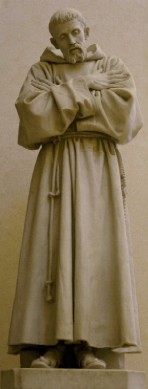
Today is the feast of Saint Josaphat. I've had a devotion to him for awhile, and have tried to visit him every time I go to Rome. He's another Saint who is difficult to get to in Saint Peter's. His remains, as seen above, are in an altar which is in the area reserved for Confessions, and they usually won't let you in unless you are going to confession. I can usually muster up enough Italian to ask to go pray at his tomb, and they usually let me in, I think mainly because I have a beard and they think I am Eastern rite (that defintely was the case once).
On my last trip a month ago I had the great priviledge of learning how to serve the Tridentine Mass. The awesome part was that the second Tridentine Mass I helped serve was a low Tridentine Mass ... in Saint Peter's ... at the altar of Saint Josaphat. It worked out rather Providentially. Father had made arrangements to say Mass, but when we got there, they had not assigned him any altar. They just said to take any altar that was open. So after walking all around and finding every altar taken, we finally ended up at Saint Josaphat, and the priest there was just finishing up his Mass. So, I gently prodded Father in that direction, and that's where we had Mass.
I thought it was pretty appropriate that with Saint Josaphat being a Ruthenian Rite Catholic Bishop that we would say the Tridentine which is much closer to the Eastern Rites (and Tradition) than the Novus Ordo. It was also appropriate that Father Benedict being a monk would say the Mass at the relics of a Martyr who was a monk. Saint Josaphat was also a Martyr for unity between East and West in the Church, and here we had a very beautiful union of East and West and Heaven and earth. You can see the reason they put Saint Josaphat's relics in one of the altars closest to Saint Peter. Definitely a memory I will treasure.
You can read more about Saint Josaphat at Catholic Encyclopedia:
St. Josaphat Kuncevyc at Catholic Encyclopedia
RS





3 comments:
I can usually muster up enough Italian to ask to go pray at his tomb, and they usually let me in, I think mainly because I have a beard and they think I am Eastern rite (that defintely was the case once).
It was the case you were once of the Eastern Church or that they let you in because they thought you were? I'm not clear.
I thought it was pretty appropriate that with Saint Josaphat being a Ruthenian Rite Catholic Bishop that we would say the Tridentine which is much closer to the Eastern Rites (and Tradition) than the Novus Ordo.
I understand what you are saying. We Greek Catholics see commonalities with both the former and current Roman Mass. The liturgical reform leading to the N.O. often referenced our Byzantine worship as an example of how Catholic worship could be in the vernacular, concelebrated, include a sharing of the Chalice with the lay faithful, with a permanent diaconate (not priests vested as deacons), with variable canons (anaphora), celebrated in the evening, with the faithful standing to receive the Eucharist, as well as the whole theology of the counciliar nature of the Church and worship rather than the monarchial nature. The Council Fathers of the Eastern Churches were frequently consulted on the reform of the Roman Liturgy.
But probably for most Greek Catholics, while we are happy to offer a polite explanation of the pastoral, spiritual and theological implications and suggestions of our practices, we run in fear from any intra-Roman debate were one side claims us as their exclusive ally.
I know this comes as a surprise to many Roman Catholics with affection for the Tridentine Mass. Certainly there is an equally long list of similarities between our worship and Tridentine (a Lectionary with two readings on a one year cycle with the OT proclaimed at the Divine Praises, less frequent communion -- and preceded by confession although with general absolution at times on our part, etc.). However, I think Greek Catholics would prefer not to have our worship reduced to "You use a lot of incense. That's nice." Tridentine worship also brings to mind among many Greek Catholics the forced latinization of our patrimony during the pre-councilar period (a tragedy we are still working out).
Oops, sorry, that is awkwardly worded.
It was definitely the case they let me in once because they thought I was Eastern Rite (not because I was Eastern Rite at one time. I'm a cradle Catholic who hasa always been Latin Rite).
As much as I love and respect the Eastern Rites, I will probably always be in the Latin Rite.
I understand what you are saying. Some of the concrete changes, like vernacular, permanent deaconate, etc, can be seen in the East. What traditional Latins are using from the East though is the idea of continuity and respect for the liturgy, in that although the East isn't as "rigid" in their liturgical laws, priests and bishops pretty much stick to the Rite, and don't just introduce all sorts of cooky ideas as is now seen in the West. At least, that is the perception I have of the East.
Post a Comment